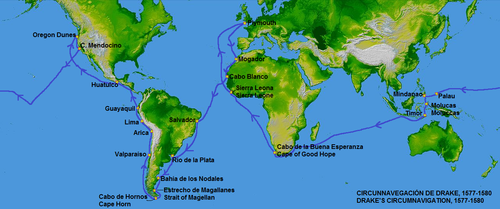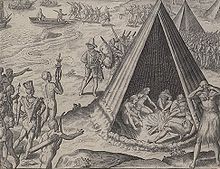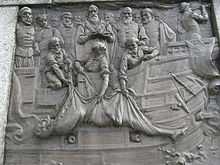
Francis Drake
Background to the schools Wikipedia
This wikipedia selection has been chosen by volunteers helping SOS Children from Wikipedia for this Wikipedia Selection for schools. SOS Children has looked after children in Africa for forty years. Can you help their work in Africa?
| Sir Francis Drake | |
|---|---|
| ca. 1540 – 27 January 1596 (aged 55) | |
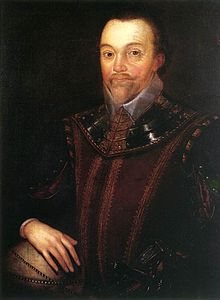 Sir Francis Drake in Buckland Abbey 16th century, oil on canvas, by Marcus Gheeraerts the Younger |
|
| Nickname | El Draque (Spanish), Draco (Latin, "The Dragon") |
| Type | Privateer |
| Place of birth | Tavistock, Devon, England |
| Place of death | Portobelo, Colón, Panama |
| Allegiance | England |
| Years active | 1563 – 1596 |
| Rank | Vice Admiral |
| Base of operations | Caribbean Sea |
| Commands | Golden Hind (previously known as Pelican) |
| Battles/wars | Anglo–Spanish War (1585) Battle of Gravelines |
| Wealth | Equiv. US $122.6 million today; #2, Forbes top-earning pirates |
Sir Francis Drake, Vice Admiral (1540 – 27 January 1596) was an English sea captain, privateer, navigator, slaver, and politician of the Elizabethan era. Elizabeth I of England awarded Drake a knighthood in 1581. He was second-in-command of the English fleet against the Spanish Armada in 1588. He also carried out the second circumnavigation of the world, from 1577 to 1580. He died of dysentery in January 1596 after unsuccessfully attacking San Juan, Puerto Rico.
His exploits were legendary, making him a hero to the English but a pirate to the Spaniards to whom he was known as El Draque. King Philip II was said to have offered a reward of 20,000 ducats, about £4 million (US$6.5M) by modern standards, for his life.
Birth and early years
Francis Drake was born in Tavistock, Devon. Although Drake's birth is not formally recorded, it is known that he was born while the Six Articles were in force. "Drake was two and twenty when he obtained the command of the Judith" (1566). This would date his birth to 1544. A date of c.1540 is suggested from two portraits: one a miniature painted by Nicholas Hilliard in 1581 when he was allegedly 42, the other painted in 1594 when he was said to be 53.
He was the eldest of the twelve sons of Edmund Drake (1518–1585), a Protestant farmer, and his wife Mary Mylwaye. The first son was reportedly named after his godfather Francis Russell, 2nd Earl of Bedford.
Because of religious persecution during the Prayer Book Rebellion in 1549, the Drake family fled from Devonshire into Kent. There the father obtained an appointment to minister to men in the King's Navy. He was ordained deacon and made vicar of Upnor Church upon the Medway. Drake's father apprenticed Francis to his neighbour, the master of a barque used for coastal trade transporting merchandise to France. The ship master was so satisfied with the young Drake's conduct that, being unmarried and childless at his death, he bequeathed the barque to Drake.
Marriage and family
Francis Drake married Mary Newman in 1569. She died 12 years later, in 1581. In 1585, Drake married Elizabeth Sydenham—born circa 1562, the only child of Sir George Sydenham, of Combe Sydenham, who was the High Sheriff of Somerset. After Drake's death, the widow Elizabeth eventually married Sir William Courtenay of Powderham. As Sir Francis Drake had no children, his estate and titles passed on to his nephew (also named Francis).
"The people of quality dislike him for having risen so high from such a lowely family; the rest say he is the main cause of wars."
Sailing career
At age 23, Drake made his first voyage to the New World, sailing with his second cousin, Sir John Hawkins, on one of a fleet of ships owned by his relatives, the Hawkins family of Plymouth. In 1568 Drake was again with the Hawkins fleet when it was trapped by the Spaniards in the Mexican port of San Juan de Ulúa. He escaped along with Hawkins.
Following the defeat at San Juan de Ulúa, Drake vowed revenge. He made two voyages to the West Indies, in 1570 and 1571, of which little is known.
In 1572, he embarked on his first major independent enterprise. He planned an attack on the Isthmus of Panama, known to the Spanish as Tierra Firme and the English as the Spanish Main. This was the point at which the silver and gold treasure of Peru had to be landed and sent overland to the Caribbean Sea, where galleons from Spain would pick it up at the town of Nombre de Dios. Drake left Plymouth on 24 May 1572, with a crew of 73 men in two small vessels, the Pascha (70 tons) and the Swan (25 tons), to capture Nombre de Dios.
His first raid was late in July 1572. Drake and his men captured the town and its treasure. When his men noticed that Drake was bleeding profusely from a wound, they insisted on withdrawing to save his life and left the treasure. Drake stayed in the area for almost a year, raiding Spanish shipping and attempting to capture a treasure shipment.
In 1573, he joined Guillaume Le Testu, a French buccaneer, in an attack on a richly laden mule train. Drake and his party found that they had captured around 20 tons of silver and gold. They buried much of the treasure, as it was too much for their party to carry. (An account of this may have given rise to subsequent stories of pirates and buried treasure.) Wounded, Le Testu was captured and later beheaded. The small band of adventurers dragged as much gold and silver as they could carry back across some 18 miles of jungle-covered mountains to where they had left the raiding boats. When they got to the coast, the boats were gone. Drake and his men, downhearted, exhausted and hungry, had nowhere to go and the Spanish were not far behind.
At this point Drake rallied his men, buried the treasure on the beach, and built a raft to sail with two volunteers ten miles along the surf-lashed coast to where they had left the flagship. When Drake finally reached its deck, his men were alarmed at his bedraggled appearance. Fearing the worst, they asked him how the raid had gone. Drake could not resist a joke and teased them by looking downhearted. Then he laughed, pulled a necklace of Spanish gold from around his neck and said "Our voyage is made, lads!" By 9 August 1573, he had returned to Plymouth.
With the success of the Panama isthmus raid, in 1577 Elizabeth I of England sent Drake to start an expedition against the Spanish along the Pacific coast of the Americas. He set out from Plymouth on 15 November 1577, but bad weather threatened him and his fleet. They were forced to take refuge in Falmouth, Cornwall, from where they returned to Plymouth for repair. After this major setback, he set sail again on 13 December, aboard Pelican, with four other ships and 164 men. He soon added a sixth ship, Mary (formerly Santa Maria), a Portuguese merchant ship that had been captured off the coast of Africa near the Cape Verde Islands. He also added its captain, Nuno da Silva, a man with considerable experience navigating in South American waters.
Drake's fleet suffered great attrition; he scuttled both Christopher and the flyboat Swan due to loss of men on the Atlantic crossing. He made landfall at the gloomy bay of San Julian, in what is now Argentina. Ferdinand Magellan had called here half a century earlier, where he put to death some mutineers. Drake's men saw weathered and bleached skeletons on the grim Spanish gibbets. They discovered that Mary had rotting timbers, so they burned the ship. Following Magellan's example, Drake tried and executed his own 'mutineer' Thomas Doughty. Drake decided to remain the winter in San Julian before attempting the Strait of Magellan.
Entering the Pacific
The three remaining ships of his convoy departed for the Magellan Strait at the southern tip of South America. A few weeks later (September 1578) Drake made it to the Pacific, but violent storms destroyed one of the three ships in the strait and caused another to return to England, leaving only the Pelican. After this passage, the Pelican was pushed south and discovered an island which Drake called Elizabeth Island. Drake, like navigators before him, probably reached a latitude of 55°S (according to astronomical data quoted in Hakluyt's The Principall Navigations, Voiages and Discoveries of the English Nation of 1589) along the Chilean coast. Despite popular lore, it seems unlikely that he reached Cape Horn or the eponymous Drake Passage, because his descriptions do not fit the first and his shipmates denied having seen an open sea. The first report of his discovery of an open channel south of Tierra del Fuego was written after the 1618 publication of the voyage of Willem Schouten and Jacob le Maire around Cape Horn in 1616.
He pushed onwards in his lone flagship, now renamed the Golden Hind in honour of Sir Christopher Hatton (after his coat of arms). The Golden Hind sailed north along the Pacific coast of South America, attacking Spanish ports and rifling towns. Some Spanish ships were captured, and Drake used their more accurate charts. Before reaching the coast of Peru, Drake visited Mocha Island, where he was seriously injured by hostile Mapuche. Later he sacked the port of Valparaíso further north in Chile where he also captured a ship full of Chilean wine.
A most consequential action
Near Lima, Drake captured a Spanish ship laden with 25,000 pesos of Peruvian gold, amounting in value to 37,000 ducats of Spanish money (about £7m by modern standards). Drake also discovered news of another ship, Nuestra Señora de la Concepción, which was sailing west towards Manila. It would come to be called the Cacafuego. Drake gave chase and eventually captured the treasure ship, which proved their most profitable capture. Aboard Nuestra Señora de la Concepción, Drake found 80 lb (36 kg) of gold, a golden crucifix, jewels, 13 chests full of royals of plate and 26 tons of silver.
Nova Albion
On 17 June 1579, Drake landed somewhere north of Spain's northern-most claim at Point Loma, in Alta California. He found a good port, landed, repaired and restocked his vessels, then stayed for a time, keeping friendly relations with the natives. He claimed the land in the name of the Holy Trinity for the English Crown as called Nova Albion—Latin for "New Britain". Assertions that he left some of his men behind as an embryo "colony" are founded on the reduced number who were with him in the Moluccas.
The precise location of the port was carefully guarded to keep it secret from the Spaniards, and several of Drake's maps may have been altered to this end. All first-hand records from the voyage, including logs, paintings and charts, were lost when Whitehall Palace burned in 1698. A bronze plaque inscribed with Drake's claim to the new lands – Drake's Plate of Brass – fitting the description in his account, was discovered in Marin County, California but was later declared a hoax. Now a National Historic Landmark, the officially recognised location of Drake's New Albion is Drakes Bay, California.
Drake headed westward across the Pacific, and a few months later reached the Moluccas, a group of islands in the south west Pacific, in eastern modern-day Indonesia. While there, Golden Hind became caught on a reef and was almost lost. After the sailors waited three days for expedient tides and dumped cargo, they freed the barque. Befriending a sultan king of the Moluccas, Drake and his men became involved in some intrigues with the Portuguese there. He made multiple stops on his way toward the tip of Africa, eventually rounded the Cape of Good Hope, and reached Sierra Leone by 22 July 1580.
Return to Plymouth
On 26 September, Golden Hind sailed into Plymouth with Drake and 59 remaining crew aboard, along with a rich cargo of spices and captured Spanish treasures. The Queen's half-share of the cargo surpassed the rest of the crown's income for that entire year. Drake was hailed as the first Englishman to circumnavigate the Earth (and the second such voyage arriving with at least one ship intact, after Elcano's in 1520). The Queen declared that all written accounts of Drake's voyages were to become the Queen's secrets of the Realm, and Drake and the other participants of his voyages on the pain of death sworn to their secrecy; she intended to keep Drake's activities away from the eyes of rival Spain. Drake presented the Queen with a jewel token commemorating the circumnavigation. Taken as a prize off the Pacific coast of Mexico, it was made of enamelled gold and bore an African diamond and a ship with an ebony hull. For her part, the Queen gave Drake a jewel with her portrait, an unusual gift to bestow upon a commoner, and one that Drake sported proudly in his 1591 portrait by Marcus Gheeraerts now at the National Maritime Museum, Greenwich. On one side is a state portrait of Elizabeth by the miniaturist Nicholas Hilliard, on the other a sardonyx cameo of double portrait busts, a regal woman and an African male. The "Drake Jewel", as it is known today, is a rare documented survivor among sixteenth-century jewels; it is conserved at the Victoria and Albert Museum, London.
Award of knighthood
Queen Elizabeth awarded Drake a knighthood aboard Golden Hind in Deptford on 4 April 1581; the dubbing being performed by a French diplomat, Monsieur de Marchaumont, who was negotiating for Elizabeth to marry the King of France's brother, Francis, Duke of Anjou. By getting the French diplomat involved in the knighting, Elizabeth was gaining the implicit political support of the French for Drake's actions. During the Victorian era, in a spirit of nationalism, the story was promoted that Elizabeth I had done the knighting.
Award of arms
After receiving his knighthood Drake unilaterally adopted the armorials of the ancient Devon family of Drake of Ash, near Musbury, to whom he claimed a distant but unspecified kinship. These arms were: Argent, a wyvern gules, and the crest, a dexter arm Proper grasping a battle axe Sable, headed Argent. The head of that family, also a distinguished sailor, Sir Bernard Drake (d.1586), angrily refuted Sir Francis's claimed kinship and his right to bear his family's arms. That dispute led to "a box in the ear" being given to Sir Francis by Sir Bernard at court, as recorded by John Prince in his "Worthies of Devon" (1697). Queen Elizabeth, in order to assuage matters, awarded Sir Francis his own coat of arms, blazoned as follows:
Sable a fess wavy between two pole-stars [Arctic and Antarctic] argent; and for his crest, a ship on a globe under ruff, held by a cable with a hand out of the clouds; over it this motto, Auxilio Divino; underneath, Sic Parvis Magna; in the rigging whereof is hung up by the heels a wivern, gules, which was the arms of Sir Bernard Drake."—Prince, "Worthies of Devon" (1697)
The above is considered by students of heraldry to be an early example of "debased arms" due to their over-complexity, particularly as regards the crest. The motto, Sic Parvis Magna, translated literally, is: "Thus great things from small things (come)". The hand out of the clouds, labelled Auxilio Divino, means "With Divine Help". The full achievement is depicted in the form of a large coloured plaster overmantel in the Lifetimes Gallery at Buckland Abbey
Nevertheless, Drake continued to quarter his new arms with the wyvern gules.
Political career
In September 1581, Drake became the Mayor of Plymouth, and was a Member of Parliament in 1581, for an unknown constituency (possibly Camelford), and again in 1584 for Bossiney and Plymouth in 1593.
Purchase of Buckland Abbey
In 1580 Drake purchased Buckland Abbey, a large manor near Yelverton in Devon. He lived there for fifteen years, until his final voyage, and it remained in his family for several generations. Buckland Abbey is now in the care of the National Trust and a number of mementos of his life are displayed there.
Spanish Armada
War broke out between Spain and England in 1585. Drake sailed to the New World and sacked the port of Santo Domingo and captured the city of Cartagena de Indias in present-day Colombia. On 6 June 1586, during the return leg of the voyage, he raided the Spanish fort of San Augustín in Spanish Florida. These acts encouraged Philip II of Spain to order planning for an invasion of England.
Cadiz raid
In a pre-emptive strike, Drake "singed the beard of the King of Spain" by sailing a fleet into Cadiz and also Corunna, two of Spain's main ports, and occupied the harbours. He destroyed 37 naval and merchant ships. The attack delayed the Spanish invasion by a year. Over the next month, Drake patrolled the Iberian coasts between Lisbon and Cape St. Vincent, intercepting and destroying ships on the Spanish supply lines. Drake estimated that he captured around 1600–1700 tons of barrel staves, enough to make 25,000 to 30,000 barrels (4,800 m3) for containing provisions.
Defeat of the Spanish Armada
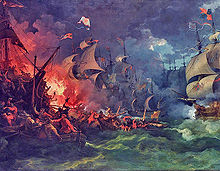
Drake was vice admiral in command of the English fleet (under Lord Howard of Effingham) when it overcame the Spanish Armada that was attempting to invade England in 1588. As the English fleet pursued the Armada up the English Channel in closing darkness, Drake broke off and captured the Spanish galleon Rosario, along with Admiral Pedro de Valdés and all his crew. The Spanish ship was known to be carrying substantial funds to pay the Spanish Army in the Low Countries. Drake's ship had been leading the English pursuit of the Armada by means of a lantern. By extinguishing this for the capture, Drake put the fleet into disarray overnight.
On the night of 29 July, along with Howard, Drake organised fire-ships, causing the majority of the Spanish captains to break formation and sail out of Calais into the open sea. The next day, Drake was present at the Battle of Gravelines. He wrote as follows to Admiral Henry Seymour after coming upon part of the Spanish Armada, whilst aboard Revenge on 31 July 1588 (21 July 1588 O.S.):
Coming up to them, there has passed some common shot between some of our fleet and some of them; and as far as we perceive, they are determined to sell their lives with blows.
The most famous (but probably apocryphal) anecdote about Drake relates that, prior to the battle, he was playing a game of bowls on Plymouth Hoe. On being warned of the approach of the Spanish fleet, Drake is said to have remarked that there was plenty of time to finish the game and still beat the Spaniards. There is no known eyewitness account of this incident and the earliest retelling of it was printed 37 years later. Adverse winds and currents caused some delay in the launching of the English fleet as the Spanish drew nearer, perhaps prompting a popular myth of Drake's cavalier attitude to the Spanish threat.
Drake-Norris Expedition
In 1589, the year after defeating the Armada, Drake and Sir John Norreys were given three tasks. They were ordered to first seek out and destroy the remaining ships, second they were to support the rebels in Lisbon, Portugal against King Philip II (then king of Spain and Portugal), and third they were to take the Azores if possible. Drake and Norreys destroyed a few ships in the harbour of La Coruña in Spain but lost more than 12,000 lives and 20 ships. This delayed Drake, and he was forced to forgo hunting the rest of the surviving ships and head on to Lisbon.
Final years
Drake's seafaring career continued into his mid-fifties. In 1595, he failed to conquer the port of Las Palmas, and following a disastrous campaign against Spanish America, where he suffered a number of defeats, he unsuccessfully attacked San Juan de Puerto Rico, eventually losing the Battle of San Juan (1595).
The Spanish gunners from El Morro Castle shot a cannonball through the cabin of Drake's flagship, and he survived; but a few weeks later, in January 1596, he died of dysentery when he was about 55, while anchored off the coast of Portobelo, Panama, where some Spanish treasure ships had sought shelter. Following his death, the English fleet withdrew.
Before dying, he asked to be dressed in his full armour. He was buried at sea in a lead coffin, near Portobelo. Divers continue to search for the coffin.
Cultural impact
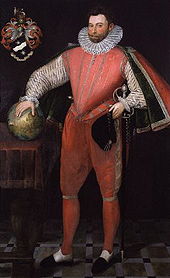
In the UK there are various places named after him, especially in Plymouth, Devon, where various places carry his name, including the naval base ( HMS Drake), Drake's Island anda roundabout named Drake Circus, along with a shopping mall named after the roundabout. Plymouth Hoe is also home to a statue of Drake.
In the United States Drakes Bay and Sir Francis Drake Boulevard of Marin County, California are both named after him, as well as the high school in San Anselmo, California. The boulevard runs between Drakes Bay at Point Reyes to Point San Quentin on San Francisco Bay. A large hotel in Union Square, San Francisco also bears his name. Additionally, the Sir Francis Drake Channel in the British Virgin Islands bears his name.
Drake's will was the focus of a vast confidence scheme which Oscar Hartzell perpetrated in the 1920s and 1930s. He convinced thousands of people, mostly in the American Midwest, that Drake's fortune was being held by the British government, and had compounded to a huge amount. If their last name was Drake they might be eligible for a share if they paid Hartzell to be their agent. The swindle continued until a copy of Drake's will was brought to Hartzell's mail fraud trial and he was convicted and imprisoned.
Modern workings of stories involving Drake include the 1961 British television series Sir Francis Drake, and the 2009 US television movie The Immortal Voyage of Captain Drake.
In 2003, he was the namesake of the Drake Tribe in Survivor: Pearl Islands.
Drake's execution of Thomas Doughty is the subject of Robert E. Howard's Solomon Kane poem, " The One Black Stain."
Nathan Drake, a fictional descendant of Sir Francis Drake, searches for lost treasure supposedly found by Sir Francis during his circumnavigation in the video game Uncharted: Drake's Fortune, and again in Uncharted 3: Drake's Deception.
Controversies
Slave trading
Drake accompanied his second cousin Sir John Hawkins in making the third English slave-trading expeditions, making fortunes through the abduction and transportation of West African people, and then exchanging them for high-value goods. The first Englishman recorded to have taken slaves from Africa was John Lok, a London trader who, in 1555, brought to England five slaves from Guinea. A second London trader taking slaves at that time was William Towerson whose fleet sailed into Plymouth following his 1556 voyage to Africa and from Plymouth on his 1557 voyage. Despite the exploits of Lok and Towerson, John Hawkins of Plymouth is widely acknowledged to be an early pioneer of the English slave trade. While Hawkins made only three such trips, ultimately the English were to dominate the trade.
Around 1563 Drake first sailed west to the Spanish Main, on a ship owned and commanded by John Hawkins, with a cargo of people forcibly removed from the coast of West Africa. The Englishmen sold their African captives into slavery in Spanish plantations. In general, the kidnapping and forced transportation of people was considered to be a criminal offence under English law at the time, although legal protection did not extend to slaves, non-Protestants or criminals. Hawkins' own account of his actions (in which Drake took part) cites two sources for their victims. One was military attacks on African towns and villages (with the assistance of rival African warlords), the other was attacking Portuguese slave ships.
Conflict in the Caribbean
During his early days as a slave-trader, Drake took an immediate dislike to the Spanish, at least in part due to their Catholicism and inherent distrust of non-Spanish. His hostility is said to have increased over an incident at San Juan de Ulúa in 1568, when Drake was sailing with the fleet of his second cousin John Hawkins. Whilst negotiating to resupply and repair at the Spanish port, the fleet were attacked by Spanish warships, with all but two of the English ships lost. Drake survived the attack by swimming. The most celebrated of Drake's adventures along the Spanish Main was his capture of the Spanish Silver Train at Nombre de Dios in March 1573. With a crew including many French privateers and Maroons—African slaves who had escaped the Spanish—Drake raided the waters around Darien (in modern Panama) and tracked the Silver Train to the nearby port of Nombre de Dios. He made off with a fortune in gold, but had to leave behind another fortune in silver, because it was too heavy to carry back to England. It was during this expedition that he climbed a high tree in the central mountains of the Isthmus of Panama and thus became the first Englishman to see the Pacific Ocean. He remarked as he saw it that he hoped one day an Englishman would be able to sail it—which he would do years later as part of his circumnavigation of the world.
When Drake returned to Plymouth after the raids, the government signed a temporary truce with King Philip II of Spain and so was unable to acknowledge Drake's accomplishment officially.
Drake was considered a hero in England and a pirate in Spain for his raids.
Ireland
In 1575, Drake was present at the Rathlin Island Massacre, which was a part of the English plantation effort in Ulster, where 600 men, women, and children were massacred after surrendering.
Francis Drake was in charge of the ships which transported John Norreys' troops to Rathlin Island, commanding a small frigate called Falcon, with a total complement of 25. At the time of the massacre, he was charged with the task of keeping Scottish vessels from bringing reinforcements to Rathlin Island. The people who were massacred were, in fact, the families of Sorley Boy MacDonnell's followers.
Execution of Thomas Doughty
On his voyage to interfere with Spanish treasure fleets, Drake had several quarrels with his co-commander Thomas Doughty and on June 3, 1578, accused him of witchcraft and charged him with mutiny and treason in a shipboard trial. Drake claimed to have a (never presented) commission from the Queen to carry out such acts and denied Doughty a trial in England. The main pieces of evidence against Doughty were the testimony of the ship's carpenter, Edward Bright, who after the trial was inexplicably promoted to master of the ship Marigold, and Doughty's admission of telling Lord William Burghley, a vocal opponent of agitating the Spanish, of the intent of the voyage. Drake consented to his request of Communion and dined with him, of which Francis Fletcher had this strange account:
"And after this holy repast, they dined also at the same table together, as cheerfully, in sobriety, as ever in their lives they had done aforetime, each cheering up the other, and taking their leave, by drinking each to other, as if some journey only had been in hand."
Drake had Thomas Doughty beheaded on 2 July 1578. When the ship's chaplain Francis Fletcher in a sermon suggested that the woes of the voyage in January 1580 were connected to the unjust demise of Doughty, Drake chained the clergyman to a hatch cover and pronounced him excommunicated.



